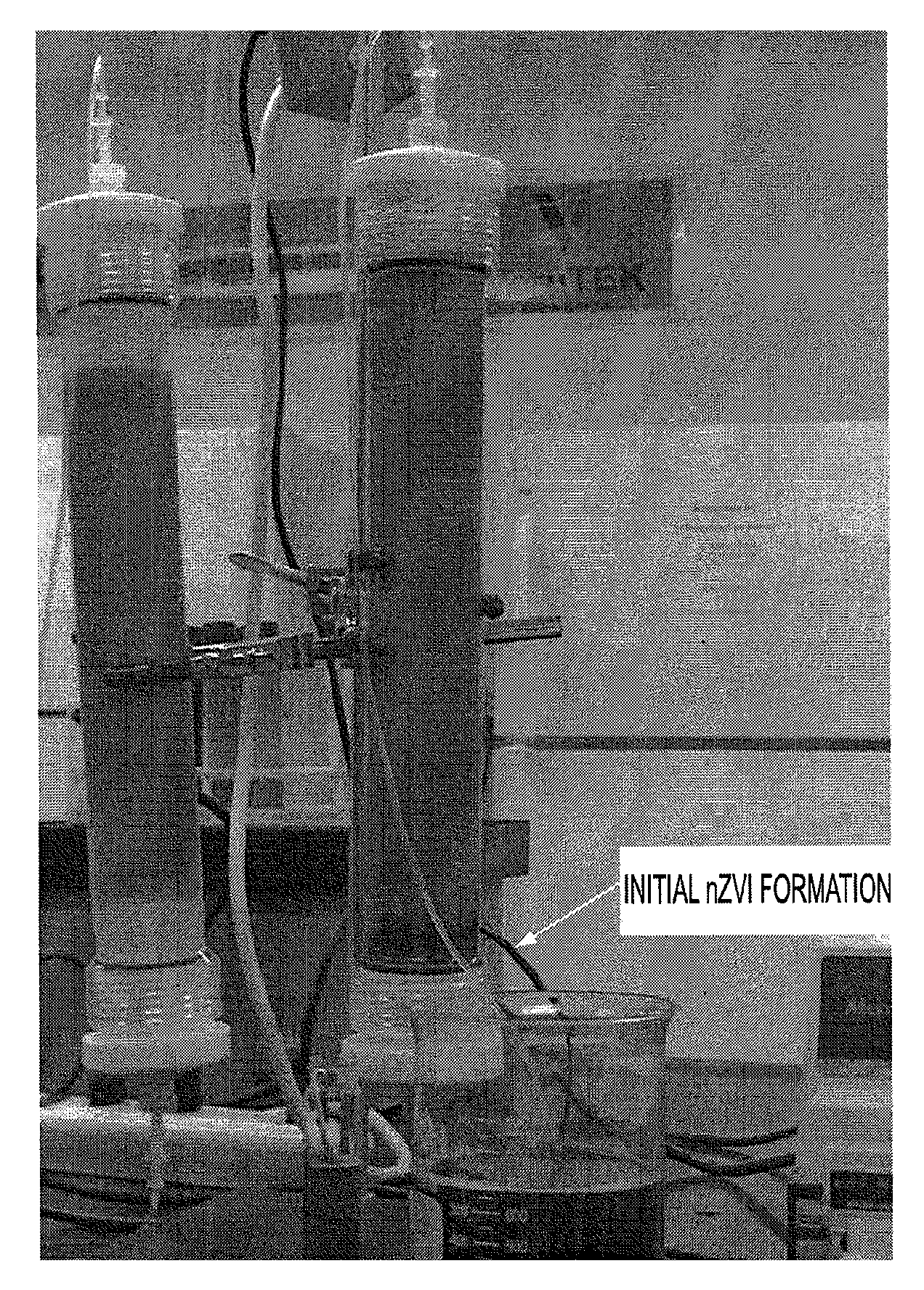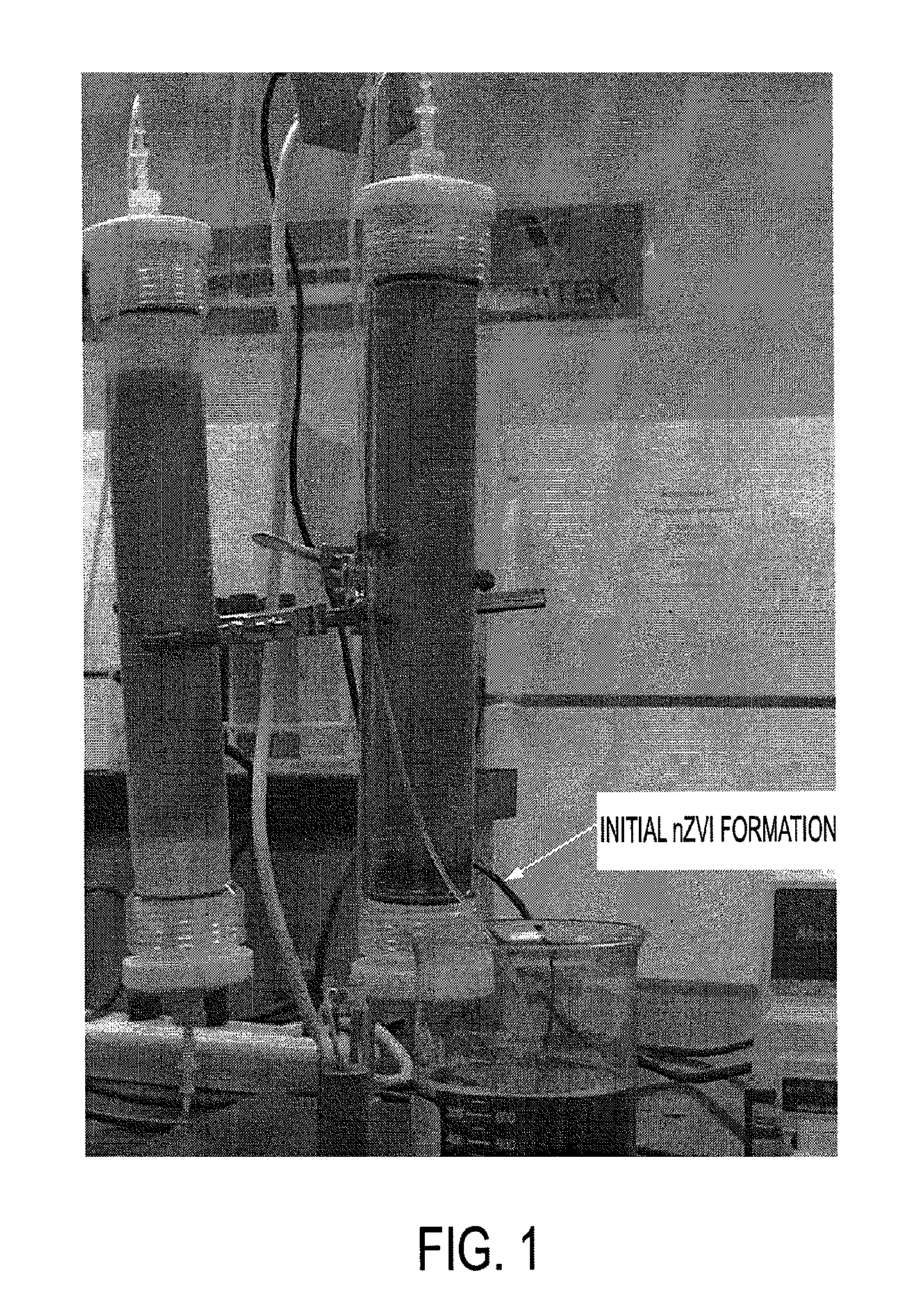Polymer coated nanoparticle activation of oxidants for remediation and methods of use thereof
a technology of oxidant and nanoparticles, applied in nanotechnology, contaminated soil reclamation, nanotechnology, etc., can solve the problems of exposing nanoparticles to other chemicals, and achieve the effects of decreasing the amount of one or more contaminants in the soil, and decreasing the amount of contaminant or contaminan
- Summary
- Abstract
- Description
- Claims
- Application Information
AI Technical Summary
Benefits of technology
Problems solved by technology
Method used
Image
Examples
example 1
Coating of NZVI, NZVMn, and Bimetallic NZVI, NZVMn
[0060]In the past, the use of nanoparticle zero valent iron (NZVI) and nanoparticle zero valent manganese (NZVMn) has been limited in environmental applications because NZVI and NZVMn particles produced by previously-existing methods can aggregate into larger particles, thus losing their surface area to mass benefit. Additionally, the NZVI and NZVMn particles can be highly reactive, and their surfaces can become quickly passivated and oxidized. In many applications, including those for remediation, there is a need for these particles to remain, and to retain reactivity, for months or even years. Coating the NZVI and NZVMn particles can greatly reduce the rapid agglomeration, oxidation, and passivation of the nanoscale particles.
[0061]In a green approach according to certain embodiments of the invention, bulk quantities of nanocomposites containing, for example, transition metals such as Cu, Ag, In, and Fe, can be produced at room tem...
example 2
Trial Production of nZVI Particles with Green Tea Extract and Ferric Chloride in the Presence of Carboxy Methyl Cellulose (CMC), VeruSOL-3™, and / or Trichloroethylene (TCE)
[0063]A series of batch tests were conducted to evaluate whether it is possible to produce nZVI via green synthesis using green tea extract and ferric chloride with the following: a) carboxy methyl cellulose (CMC); b) VeruSOL™-3; and c) trichloroethylene (TCE). Testing conditions are shown in Table 1. The photograph of the test vials is shown in FIG. 6. In Test Vials I-1 and I-2, the compatibility of carboxy methyl cellulose with VeruSOL™-3 was evaluated at two CMC concentrations. In both cases, separation into phases was not observed when CMC and VeruSOL™-3 were mixed together. In Test Vials I-2 and I-3, the ability of carboxy methyl cellulose to chelate the iron in ferric chloride was evaluated. When 4 mL of a saturated CMC solution was added to a 0.1 N ferric chloride, precipitation of iron was observed as seen ...
example 3
Production of nZVI Particles in Dispersion Using Attritor
[0067]Zero valent iron nanoparticles can be prepared through milling or grinding techniques, as described in U.S. Pat. No. 7,128,841 to Zhang (incorporated by reference in its entirety). Iron particles up to 10 μm in diameter are combined with one or more dispersing agents, such as sodium polymethacrylate and ammonia polymethacrylate (sold under the trade names Darvan 811 and Darvan C, respectively), and water. This composition can comprise, for example, about 69% water, about 29% iron particles, and about 1-2% dispersant. This composition is then fed into a device called an attritor. The attritor chamber contains a grinding media, such as iron or steel beads of 100-250 μm diameter, which fills about 80-85% of the chamber. The attritor central shaft is then set in motion at a speed of about 2200-2400 rpm. The motion of the central shaft in turn moves grinding rods, which create shear forces that grind the dispersed iron partic...
PUM
| Property | Measurement | Unit |
|---|---|---|
| diameter | aaaaa | aaaaa |
| diameter | aaaaa | aaaaa |
| diameter | aaaaa | aaaaa |
Abstract
Description
Claims
Application Information
 Login to View More
Login to View More - R&D
- Intellectual Property
- Life Sciences
- Materials
- Tech Scout
- Unparalleled Data Quality
- Higher Quality Content
- 60% Fewer Hallucinations
Browse by: Latest US Patents, China's latest patents, Technical Efficacy Thesaurus, Application Domain, Technology Topic, Popular Technical Reports.
© 2025 PatSnap. All rights reserved.Legal|Privacy policy|Modern Slavery Act Transparency Statement|Sitemap|About US| Contact US: help@patsnap.com



